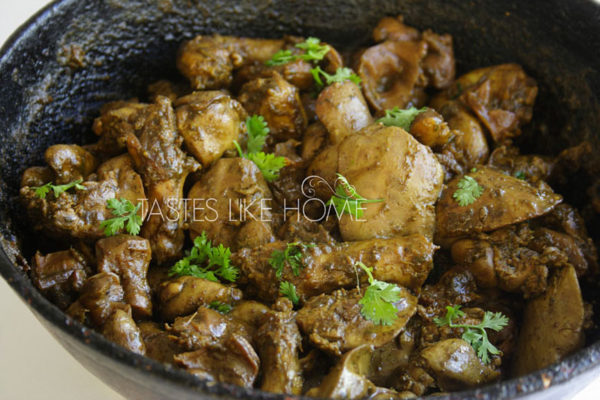Hi Everyone,
What’s Cooking is a series in which I address questions you may have about food and cooking but are too shy to ask.
The eating of offal and the extremities of an animal is mostly about the texture: the almost melting tendons of cowheel, the grizzle of chicken feet, and the gelatinous thickness of pig trotters cooked in a stew or soup. Gizzards, when cooked until soft give a good chew, one that is not rubbery. Liver becomes tender and creamy.

For the purpose of the column, I am referring to chicken livers and gizzards.
When shopping at the meat section of markets or supermarkets one can find containers of liver, gizzards, or a combo of livers and gizzards. Some producers offer necks with their chicken livers and gizzards combo. There is one dish that immediately comes to mind – bunjal liver and gizzards (dry curry). Dhal and rice are ready accompaniments but these tasty bits of meat work really well as cutters when liming.
Here in Barbados livers and gizzards are seasoned, fried, and sold as snacks. If you want, you can get a sandwich made, such as a liver cutter – a salt bread (popular Bajan bread roll), halved, stuffed with fried liver and a generous helping of pepper sauce. So good!
Today I want to address a question I received about cooking the combo of liver and gizzards together in the style of dry curry we Guyanese refer to as bunjal. The reader expressed frustration that by time the curry is done cooking, the livers have disintegrated, and have become like bits of curd in the pan. Sounds familiar? We’ve all been there.
Gizzards take a longer time to cook than livers, therefore, adding the two ingredients at the same time causes one to cook properly and the other one to overcook to the point where it loses its form. Liver is one of those ingredients that you have to cook quickly, if it is overcooked, it becomes hard, grey and dry.
If cooked too long in a sauce or gravy, it can break down and melt becoming a part of the sauce/gravy. Because of this, when cooking liver and gizzards together, the cooking of the ingredients should be staggered. In other words, one ingredient (in this case the gizzards) should be given a head start so that they can become soft and tender before the livers are added to the pan.
Before adding the livers to the pan of cooking gizzards, be sure that the livers are drained well and pat dry. If they are overly wet, the livers add unwanted moisture to the curry and will “stew” rather than sauté, fry or cook dry.
Once the livers are added – nestled between the other meat or dropped in and quickly tossed – they should take only a few minutes to cook and it would be best not to cover the pan.
Covering the pan would cause steam to develop creating a moist environment; this moist environment can cause the curry to “spring water”. It will take some time for the water to evaporate and the curry to dry down, this is when the livers start to break down and melt.
How to tell when the livers are done cooking? You can judge by looks – the livers would grow slightly in size, look firm and smooth on the outside – or, to be absolutely sure, remove a piece of liver from the pan and cut it. The insides should be pink not red or bloody. Shut off the stove and the residual heat will take care of the doneness.
An important thing to note is this, when the livers are added, and you nestle or turn them once, that’s enough. Resist the urge to constantly stir the pan; let the livers sit and cook until done.
Cynthia
www.tasteslikehome.org








